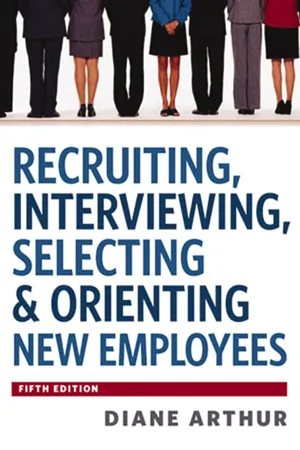
- 384 pages
- English
- ePUB (mobile friendly)
- Available on iOS & Android
Recruiting, Interviewing, Selecting and Orienting New Employees
About this book
Nothing is more important to the productivity of an organization than its hiring program. Broken into four parts, this book spans the journey from recruitment to interviews to making an offer to orientation.
As president of a human resources development firm, author Diane Arthur is full of insights on the latest staffing challenges, including changes in technology such as virtual interviews and recruitment, web-based orientations, and the use of electronic files and social media.
Recruiting, Interviewing, Selecting & Orienting New Employees offers practical information to help your business overcome these challenges and beat out competitors for the best talent. You’ll learn about:
- interview methods,
- documentation issues,
- reference-checking,
- orientation programs,
- applicant testing,
- FMLA legislation,
- record keeping,
- I-9 compliance,
- and much more.
Recruiting, Interviewing, Selecting & Orienting New Employees has long been the go-to reference on every aspect of the employment process. Packed with forms, checklists, guidelines, and ready-to-use interview questions, the revised fifth edition provides you with the tools you need to get employees on board and ready to succeed.
Frequently asked questions
- Essential is ideal for learners and professionals who enjoy exploring a wide range of subjects. Access the Essential Library with 800,000+ trusted titles and best-sellers across business, personal growth, and the humanities. Includes unlimited reading time and Standard Read Aloud voice.
- Complete: Perfect for advanced learners and researchers needing full, unrestricted access. Unlock 1.4M+ books across hundreds of subjects, including academic and specialized titles. The Complete Plan also includes advanced features like Premium Read Aloud and Research Assistant.
Please note we cannot support devices running on iOS 13 and Android 7 or earlier. Learn more about using the app.
Information
PART I
Recruiting Qualified People
CHAPTER 1
Recruitment Challenges
Weather the Impact of a Fluctuating Economy
Make Recruitment Efforts Succeed
ABC Guidelines for Successful Recruitment
Table of contents
- Cover Page
- Title Page
- Copyright Page
- Dedication
- Contents
- Preface
- Part I: Recruiting Qualified People
- Part II: Interviewing Applicants
- Part III: Selecting the Best Fit
- Part IV: Orienting New Employees
- Appendixes
- Notes
- Index